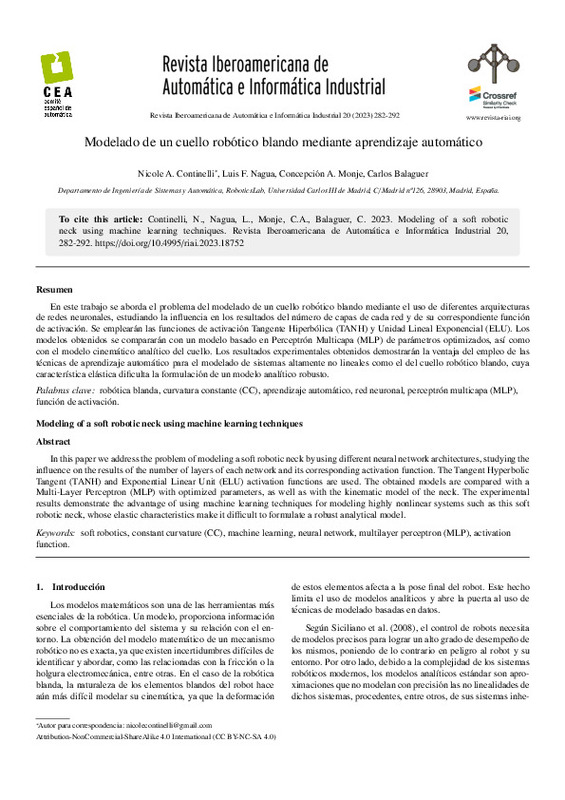Becerra, Y., Arbulu, M., Soto, S., Martinez, F., 2019. A comparison among the denavit-hartenberg, the screw theory, and the iterative methods to solve inverse kinematics for assistant robot arm. In: International Conference on Swarm Intelligence. Springer, pp. 447-457. https://doi.org/10.1007/978-3-030-26369-0_42
Brownlee, J., Mastery, M. L., 2017. Deep Learning with Python: Develop Deep Learning Models on Theano and TensorFlow Using Keras. Machine Learning Mastery. URL: https://books.google.es/books?id=eJw2nQAACAAJ
Clevert, D.-A., Unterthiner, T., Hochreiter, S., 2015. Fast and accurate deep network learning by exponential linear units (elus).URL: https://arxiv.org/abs/1511.07289 DOI: 10.48550/ARXIV.1511.07289
[+]
Becerra, Y., Arbulu, M., Soto, S., Martinez, F., 2019. A comparison among the denavit-hartenberg, the screw theory, and the iterative methods to solve inverse kinematics for assistant robot arm. In: International Conference on Swarm Intelligence. Springer, pp. 447-457. https://doi.org/10.1007/978-3-030-26369-0_42
Brownlee, J., Mastery, M. L., 2017. Deep Learning with Python: Develop Deep Learning Models on Theano and TensorFlow Using Keras. Machine Learning Mastery. URL: https://books.google.es/books?id=eJw2nQAACAAJ
Clevert, D.-A., Unterthiner, T., Hochreiter, S., 2015. Fast and accurate deep network learning by exponential linear units (elus).URL: https://arxiv.org/abs/1511.07289 DOI: 10.48550/ARXIV.1511.07289
Continelli, N., Nagua, L., Monje, C. A., Balaguer, C., 2022. Identificaci'on de un cuello robótico blando mediante aprendizaje automático. In: Jornadas de Robótica, Educación y Bioingeniería, pp. 124-130.
Copaci, D., Muñoz, J., González, I., Monje, C. A., Moreno, L., 2020. SMAdriven soft robotic neck: Design, control and validation. IEEE Access 8, 199492-199502. https://doi.org/10.1109/ACCESS.2020.3035510
Gholamy, A., Kreinovich, V., Kosheleva, O., 2018. Why 70/30 or 80/20 relation between training and testing sets: A pedagogical explanation. International Journal of Intelligent Technologies and Applied Statistics 11 (2), 105-111.
Goodfellow, I., Pouget-Abadie, J., Mirza, M., Xu, B., Warde-Farley, D., Ozair, S., Courville, A., Bengio, Y., 2014. Generative adversarial nets. Advances in neural information processing systems 27.
Goodfellow, I. J., Bengio, Y., Courville, A., 2016. Deep Learning. MIT Press, Cambridge, MA, USA.
Hernández-Vicen, J., Martínez, S., Balaguer, C., 2021. Principios básicos para el desarrollo de una aplicaci'on de bi-manipulación de cajas por un robot humanoide. Revista Iberoamericana de Automática e Informática Industrial 18 (2), 129-137. https://doi.org/10.4995/riai.2020.13097
Jin, L., Li, S., Yu, J., He, J., 2018. Robot manipulator control using neural networks: A survey. Neurocomputing 285, 23-34. https://doi.org/10.1016/j.neucom.2018.01.002
Jiokou Kouabon, K., Melingui, A., Lakhal, O., Kom, M., Merzouki, R., 2020. A learning framework to inverse kinematics of redundant manipulators. IFACPapersOnLine 53 (2), 9912-9917. https://doi.org/10.1016/j.ifacol.2020.12.2699
Jones, B. A., Walker, I. D., 2006. Practical kinematics for real-time implementation of continuum robots. IEEE Transactions on Robotics 22 (6), 1087- 1099. https://doi.org/10.1109/TRO.2006.886268
Köker, R., C¸ akar, T., Sari, Y., 2014. A neural-network committee machine approach to the inverse kinematics problem solution of robotic manipulators. Engineering with Computers 30 (4), 641-649. https://doi.org/10.1007/s00366-013-0313-2
Mena, L., Monje, C. A., Nagua, L., Muñoz, J., Balaguer, C., 2020. Test bench for evaluation of a soft robotic link. Frontiers in Robotics and AI 7, 27. https://doi.org/10.3389/frobt.2020.00027
Muñoz, J., Monje, C. A., Nagua, L. F., Balaguer, C., 2020. A graphical tuning method for fractional order controllers based on iso-slope phase curves. ISA transactions 105, 296-307. https://doi.org/10.1016/j.isatra.2020.05.045
Nagua, L., Monje, C. A., Muñoz, J., Balaguer, C., 2018a. Design and performance validation of a cable-driven soft robotic neck. In: Proc. Actas de las Jornadas Nacionales de Robótica. pp. 1-5. URL: http://hdl.handle.net/10016/30567
Nagua, L., Muñoz, J., Monje, C. A., Balaguer, C., 2018b. A first approach to a proposal of a soft robotic link acting as a neck. Actas de las XXXIX Jornadas de Automática, Badajoz, 5-7 de Septiembre de 2018. https://doi.org/10.17979/spudc.9788497497565.0522
Nori, F., Jamone, L., Sandini, G., Metta, G., 2007. Accurate control of a humanlike tendon-driven neck. In: 2007 7th IEEE-RAS International Conference on Humanoid Robots. IEEE, pp. 371-378. https://doi.org/10.1109/ICHR.2007.4813896
Pedregosa, F., Varoquaux, G., Gramfort, A., Michel, V., Thirion, B., Grisel, O., Blondel, M., Prettenhofer, P.,Weiss, R., Dubourg, V., Vanderplas, J., Passos,A., Cournapeau, D., Brucher, M., Perrot, M., Duchesnay, E., 2011. Scikitlearn: Machine learning in Python. Journal of Machine Learning Research 12, 2825-2830.
Perlich, C., 2010. Learning curves in machine learning. In: Encyclopedia of Machine Learning. p. 5.
Reinecke, J., Deutschmann, B., Fehrenbach, D., 2016. A structurally flexible humanoid spine based on a tendon-driven elastic continuum. In: 2016 IEEE International Conference on Robotics and Automation (ICRA). IEEE, pp. 4714-4721. https://doi.org/10.1109/ICRA.2016.7487672
Relaño, C., Muñoz, J., Monje, C. A., Martínez, S., González, D., 2022. Modeling and control of a soft robotic arm based on a fractional order control approach. Fractal and Fractional 7 (1), 8. https://doi.org/10.3390/fractalfract7010008
Segota, S. B., Andeli'c, N., Mrzljak, V., Lorencin, I., Kuric, I., Car, Z., 2021. Utilization of multilayer perceptron for determining the inverse kinematics of an industrial robotic manipulator. International Journal of Advanced Robotic Systems 18 (4), 1729881420925283. https://doi.org/10.1177/1729881420925283
Sharma, S., Sharma, S., Athaiya, A., 2017. Activation functions in neural networks. towards data science 6 (12), 310-316. https://doi.org/10.33564/IJEAST.2020.v04i12.054
Siciliano, B., Khatib, O., Kr¨oger, T., 2008. Springer handbook of robotics. Vol. 200. Springer. https://doi.org/10.1007/978-3-540-30301-5
Thuruthel, T. G., Falotico, E., Renda, F., Laschi, C., 2017. Learning dynamic models for open loop predictive control of soft robotic manipulators. Bioinspiration & biomimetics 12 (6), 066003. https://doi.org/10.1088/1748-3190/aa839f
Tran, L., Zhang, Z., Yeo, S., Sun, Y., Yang, G., 2011. Control of a cable-driven 2-dof joint module with a flexible backbone. In: 2011 IEEE Conference on Sustainable Utilization and Development in Engineering and Technology (Student). IEEE, pp. 150-155. https://doi.org/10.1109/STUDENT.2011.6089343
Wang, X., Liu, X., Chen, L., Hu, H., 2021. Deep-learning damped least squares method for inverse kinematics of redundant robots. Measurement 171, 108821. https://doi.org/10.1016/j.measurement.2020.108821
Webster III, R. J., Jones, B. A., 2010. Design and kinematic modeling of constant curvature continuum robots: A review. The International Journal of Robotics Research 29 (13), 1661-1683. https://doi.org/10.1177/0278364910368147
Zaki, M. J., Meira, Jr, W., 2020. Data Mining and Machine Learning: Fundamental Concepts and Algorithms, 2nd Edition. Cambridge University Press. https://doi.org/10.1017/9781108564175
Zou, J., Han, Y., So, S.-S., 2009. Overview of artificial neural networks. Artificial neural networks: methods and applications, 14-22. https://doi.org/10.1007/978-1-60327-101-1_2
[-]








